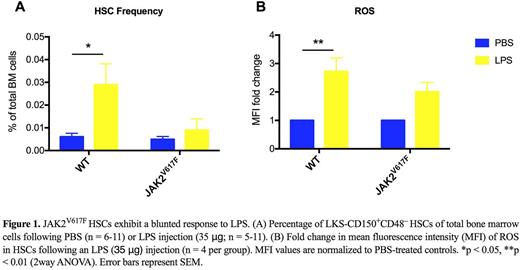Abstract
Increased inflammation is common in patients with myeloproliferative neoplasms (MPN) and drives many of the debilitating constitution symptoms associated with the disease.Inflammation drives hematopoietic stem cells (HSC) out of quiescence and into cycle. Takizawa et al. (Cell Stem Cell, 2017) recently showed that Toll-like receptor 4 (TLR4) activation induces proliferative stress in HSCs that is mediated by reactive oxygen species (ROS). This proliferation stress impairs HSC regenerative ability and competitive fitness. We propose that chronic inflammation has a central role in the clonal expansion of JAK2V617F HSCs for several reasons. First, JAK2V617F monocytes from MPN patients produce elevated amounts of the inflammatory cytokine tumor necrosis factor-alpha (TNF) for a prolonged period of time following stimulation with lipopolysaccharide (LPS), a major component of Gram-negative bacteria. Secondly, there is a positive correlation between TNF concentration in plasma and JAK2V617F allele burden suggesting that TNF promotes expansion of the JAK2V617F clone. Finally, JAK2V617F mutant cells fail to expand in TNF-/- mice. Thus, we hypothesize that the JAK2V617F mutation protects hematopoietic stem cells from inflammation giving them a selective advantage in the context of chronic inflammation.
To investigate the response of JAK2V617F HSCs to acute inflammation, we injected mice with a single dose of 35 μg LPS then quantified HSCs (defined as Lineage-ckit+Sca-1+CD150+CD48-) after 24 hours. Vehicle-treated controls were injected with sterile PBS. Following acute inflammation, the frequency of wild-type HSCs significantly expanded compared to vehicle-treated controls (p = 0.027). The frequency of JAK2V617F HSCs did not significantly expand following acute inflammation. To model chronic inflammation, we injected mice daily with 5 μg LPS for 4-6 weeks. The frequency of either wild-type or JAK2V617F HSCs did not significantly change following 4-6 weeks of chronic TLR4 stimulation.
LPS is commonly used to induce inflammation by activating signaling pathways downstream of the Toll-like receptor 4 (TLR4), including MyD88 and TRIF-p38MAPK. TLR4 activation also increases reactive oxygen species (ROS), leading to cell proliferation and DNA damage. To detect intracellular ROS, we treated HSCs with a ROS/RNS sensitive dye (CM-H2DCFDA) then analyzed HSCs by flow cytometry. Following acute LPS stimulation, wild-type HSCs had significantly elevated ROS compared to vehicle-treated controls (p = 0.001). JAK2V617F HSCs did not exhibit a significant increase in ROS following acute LPS treatment. Finally, we analyzed LPS-induced DNA damage in JAK2V617F and wild-type HSCs by quantifying γH2AX foci using the Amnis Imagestream flow cytometer. The percent of wild-type HSCs with greater than three γH2AX+ foci was significantly increased following LPS treatment. However, the percent of JAK2V617F HSCs with greater than three γH2AX+ foci was not significantly increased following LPS stimulation.
In conclusion, JAK2V617F HSCs exhibit reduced proliferation, ROS and DNA damage compared to normal HSCs in response to acute LPS-induced inflammation. Because inflammation-induced HSC exhaustion is mediated by induction of the TLR4-TRIF-ROS axis, JAK2V617F HSCs may be protected from ROS-induced proliferative stress, allowing for their selection in the context of chronic inflammation.
No relevant conflicts of interest to declare.
Author notes
Asterisk with author names denotes non-ASH members.


This feature is available to Subscribers Only
Sign In or Create an Account Close Modal